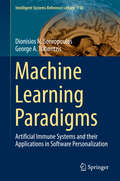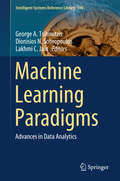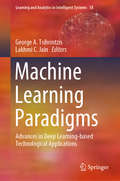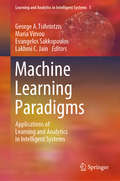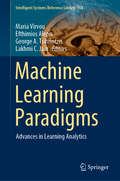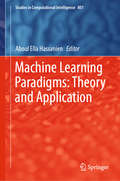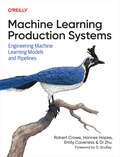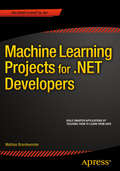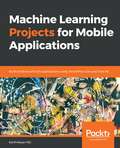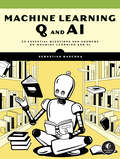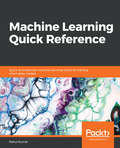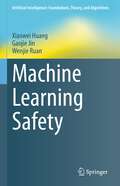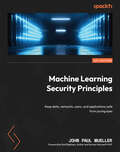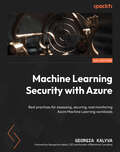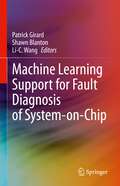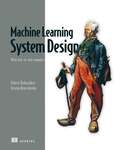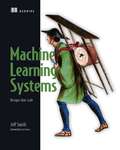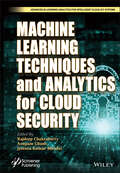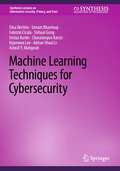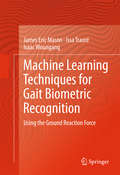- Table View
- List View
Machine Learning Paradigms
by George A. Tsihrintzis Dionisios N. SotiropoulosThis timely book presents Applications in Recommender Systems which are making recommendations using machine learning algorithms trained via examples of content the user likes or dislikes. Recommender systems built on the assumption of availability of both positive and negative examples do not perform well when negative examples are rare. It is exactly this problem that the authors address in the monograph at hand. Specifically, the books approach is based on one-class classification methodologies that have been appearing in recent machine learning research. The blending of recommender systems and one-class classification provides a new very fertile field for research, innovation and development with potential applications in "big data" as well as "sparse data" problems. The book will be useful to researchers, practitioners and graduate students dealing with problems of extensive and complex data. It is intended for both the expert/researcher in the fields of Pattern Recognition, Machine Learning and Recommender Systems, as well as for the general reader in the fields of Applied and Computer Science who wishes to learn more about the emerging discipline of Recommender Systems and their applications. Finally, the book provides an extended list of bibliographic references which covers the relevant literature completely.
Machine Learning Paradigms: Advances in Data Analytics (Intelligent Systems Reference Library #149)
by Lakhmi C. Jain George A. Tsihrintzis Dionisios N. SotiropoulosThis book explores some of the emerging scientific and technological areas in which the need for data analytics arises and is likely to play a significant role in the years to come. At the dawn of the 4th Industrial Revolution, data analytics is emerging as a force that drives towards dramatic changes in our daily lives, the workplace and human relationships. Synergies between physical, digital, biological and energy sciences and technologies, brought together by non-traditional data collection and analysis, drive the digital economy at all levels and offer new, previously-unavailable opportunities. The need for data analytics arises in most modern scientific disciplines, including engineering; natural-, computer- and information sciences; economics; business; commerce; environment; healthcare; and life sciences. Coming as the third volume under the general title MACHINE LEARNING PARADIGMS, the book includes an editorial note (Chapter 1) and an additional 12 chapters, and is divided into five parts: (1) Data Analytics in the Medical, Biological and Signal Sciences, (2) Data Analytics in Social Studies and Social Interactions, (3) Data Analytics in Traffic, Computer and Power Networks, (4) Data Analytics for Digital Forensics, and (5) Theoretical Advances and Tools for Data Analytics. This research book is intended for both experts/researchers in the field of data analytics, and readers working in the fields of artificial and computational intelligence as well as computer science in general who wish to learn more about the field of data analytics and its applications. An extensive list of bibliographic references at the end of each chapter guides readers to probe further into the application areas of interest to them.
Machine Learning Paradigms: Advances in Deep Learning-based Technological Applications (Learning and Analytics in Intelligent Systems #18)
by Lakhmi C. Jain George A. TsihrintzisAt the dawn of the 4th Industrial Revolution, the field of Deep Learning (a sub-field of Artificial Intelligence and Machine Learning) is growing continuously and rapidly, developing both theoretically and towards applications in increasingly many and diverse other disciplines. The book at hand aims at exposing its reader to some of the most significant recent advances in deep learning-based technological applications and consists of an editorial note and an additional fifteen (15) chapters. All chapters in the book were invited from authors who work in the corresponding chapter theme and are recognized for their significant research contributions. In more detail, the chapters in the book are organized into six parts, namely (1) Deep Learning in Sensing, (2) Deep Learning in Social Media and IOT, (3) Deep Learning in the Medical Field, (4) Deep Learning in Systems Control, (5) Deep Learning in Feature Vector Processing, and (6) Evaluation of Algorithm Performance. This research book is directed towards professors, researchers, scientists, engineers and students in computer science-related disciplines. It is also directed towards readers who come from other disciplines and are interested in becoming versed in some of the most recent deep learning-based technological applications. An extensive list of bibliographic references at the end of each chapter guides the readers to probe deeper into their application areas of interest.
Machine Learning Paradigms: Applications of Learning and Analytics in Intelligent Systems (Learning and Analytics in Intelligent Systems #1)
by Lakhmi C. Jain Maria Virvou George A. Tsihrintzis Evangelos SakkopoulosThis book is the inaugural volume in the new Springer series on Learning and Analytics in Intelligent Systems. The series aims at providing, in hard-copy and soft-copy form, books on all aspects of learning, analytics, advanced intelligent systems and related technologies. These disciplines are strongly related and mutually complementary; accordingly, the new series encourages an integrated approach to themes and topics in these disciplines, which will result in significant cross-fertilization, research advances and new knowledge creation. To maximize the dissemination of research findings, the series will publish edited books, monographs, handbooks, textbooks and conference proceedings. This book is intended for professors, researchers, scientists, engineers and students. An extensive list of references at the end of each chapter allows readers to probe further into those application areas that interest them most.
Machine Learning Paradigms: Artificial Immune Systems And Their Applications In Software Personalization (Intelligent Systems Reference Library #118)
by Lakhmi C. Jain Maria Virvou George A. Tsihrintzis Efthimios AlepisThis book presents recent machine learning paradigms and advances in learning analytics, an emerging research discipline concerned with the collection, advanced processing, and extraction of useful information from both educators’ and learners’ data with the goal of improving education and learning systems. In this context, internationally respected researchers present various aspects of learning analytics and selected application areas, including: <P><P> • Using learning analytics to measure student engagement, to quantify the learning experience and to facilitate self-regulation; <P><P> • Using learning analytics to predict student performance; <P><P> • Using learning analytics to create learning materials and educational courses; and <P><P> • Using learning analytics as a tool to support learners and educators in synchronous and asynchronous eLearning. <P><P> The book offers a valuable asset for professors, researchers, scientists, engineers and students of all disciplines. Extensive bibliographies at the end of each chapter guide readers to probe further into their application areas of interest.
Machine Learning Paradigms: Theory and Application (Studies in Computational Intelligence #801)
by Aboul Ella HassanienThe book focuses on machine learning. Divided into three parts, the first part discusses the feature selection problem. The second part then describes the application of machine learning in the classification problem, while the third part presents an overview of real-world applications of swarm-based optimization algorithms. The concept of machine learning (ML) is not new in the field of computing. However, due to the ever-changing nature of requirements in today’s world it has emerged in the form of completely new avatars. Now everyone is talking about ML-based solution strategies for a given problem set. The book includes research articles and expository papers on the theory and algorithms of machine learning and bio-inspiring optimization, as well as papers on numerical experiments and real-world applications.
Machine Learning Pocket Reference: Working with Structured Data in Python
by Matt HarrisonWith detailed notes, tables, and examples, this handy reference will help you navigate the basics of structured machine learning. Author Matt Harrison delivers a valuable guide that you can use for additional support during training and as a convenient resource when you dive into your next machine learning project.Ideal for programmers, data scientists, and AI engineers, this book includes an overview of the machine learning process and walks you through classification with structured data. You’ll also learn methods for clustering, predicting a continuous value (regression), and reducing dimensionality, among other topics.This pocket reference includes sections that cover:Classification, using the Titanic datasetCleaning data and dealing with missing dataExploratory data analysisCommon preprocessing steps using sample dataSelecting features useful to the modelModel selectionMetrics and classification evaluationRegression examples using k-nearest neighbor, decision trees, boosting, and moreMetrics for regression evaluationClusteringDimensionality reductionScikit-learn pipelines
Machine Learning Production Systems: Engineering Machine Learning Models and Pipelines
by Hannes Hapke Robert Crowe Emily Caveness Di ZhuUsing machine learning for products, services, and critical business processes is quite different from using ML in an academic or research setting—especially for recent ML graduates and those moving from research to a commercial environment. Whether you currently work to create products and services that use ML, or would like to in the future, this practical book gives you a broad view of the entire field.Authors Robert Crowe, Hannes Hapke, Emily Caveness, and Di Zhu help you identify topics that you can dive into deeper, along with reference materials and tutorials that teach you the details. You'll learn the state of the art of machine learning engineering, including a wide range of topics such as modeling, deployment, and MLOps. You'll learn the basics and advanced aspects to understand the production ML lifecycle.This book provides four in-depth sections that cover all aspects of machine learning engineering:Data: collecting, labeling, validating, automation, and data preprocessing; data feature engineering and selection; data journey and storageModeling: high performance modeling; model resource management techniques; model analysis and interoperability; neural architecture searchDeployment: model serving patterns and infrastructure for ML models and LLMs; management and delivery; monitoring and loggingProductionalizing: ML pipelines; classifying unstructured texts and images; genAI model pipelines
Machine Learning Projects for .NET Developers
by Mathias BrandewinderMachine Learning Projects for . NET Developers shows you how to build smarter . NET applications that learn from data, using simple algorithms and techniques that can be applied to a wide range of real-world problems. You'll code each project in the familiar setting of Visual Studio, while the machine learning logic uses F#, a language ideally suited to machine learning applications in . NET. If you're new to F#, this book will give you everything you need to get started. If you're already familiar with F#, this is your chance to put the language into action in an exciting new context. In a series of fascinating projects, you'll learn how to: Build an optical character recognition (OCR) system from scratch Code a spam filter that learns by example Use F#'s powerful type providers to interface with external resources (in this case, data analysis tools from the R programming language) Transform your data into informative features, and use them to make accurate predictions Find patterns in data when you don't know what you're looking for Predict numerical values using regression models Implement an intelligent game that learns how to play from experience Along the way, you'll learn fundamental ideas that can be applied in all kinds of real-world contexts and industries, from advertising to finance, medicine, and scientific research. While some machine learning algorithms use fairly advanced mathematics, this book focuses on simple but effective approaches. If you enjoy hacking code and data, this book is for you. What you'll learn Learn vocabulary and landscape of machine learning Recognize patterns in problems and how to solve them Learn simple prediction algorithms and how to apply them Develop, diagnose and tune your models Write elegant, efficient and bug-free functional code with F# Who this book is for Machine Learning Projects for . NET Developers is for intermediate to advanced . NET developers who are comfortable with C#. No prior experience of machine learning techniques is required. If you're new to F#, you'll find everything you need to get started. If you're already familiar with F#, you'll find a wealth of new techniques here to interest and inspire you. While some machine learning algorithms use fairly advanced mathematics, this book focuses on simple but effective approaches and how they can be used in actual code. If you enjoy hacking code and data, this book is for you. Table of Contents Chapter 1: 256 Shades of Gray: Building A Program to Automatically Recognize Images of Numbers Chapter 2: Spam or Ham? Detecting Spam in Text Using Bayes' Theorem Chapter 3: The Joy of Type Providers: Finding and Preparing Data, From Anywhere Chapter 4: Of Bikes and Men: Fitting a Regression Model to Data with Gradient Descent Chapter 5: You Are Not An Unique Snowflake: Detecting Patterns with Clustering and Principle Component Analysis Chapter 6: Trees and Forests: Making Predictions from Incomplete Data Chapter 7: A Strange Game: Learning From Experience with Reinforcement Learning Chapter 8: Digits, Revisited: Optimizing and Scaling Your Algorithm Code Chapter 9: Conclusion
Machine Learning Projects for Mobile Applications: Build Android and iOS applications using TensorFlow Lite and Core ML
by Karthikeyan NgBring magic to your mobile apps using TensorFlow Lite and Core MLKey FeaturesExplore machine learning using classification, analytics, and detection tasks.Work with image, text and video datasets to delve into real-world tasksBuild apps for Android and iOS using Caffe, Core ML and Tensorflow LiteBook DescriptionMachine learning is a technique that focuses on developing computer programs that can be modified when exposed to new data. We can make use of it for our mobile applications and this book will show you how to do so.The book starts with the basics of machine learning concepts for mobile applications and how to get well equipped for further tasks. You will start by developing an app to classify age and gender using Core ML and Tensorflow Lite. You will explore neural style transfer and get familiar with how deep CNNs work. We will also take a closer look at Google’s ML Kit for the Firebase SDK for mobile applications. You will learn how to detect handwritten text on mobile. You will also learn how to create your own Snapchat filter by making use of facial attributes and OpenCV. You will learn how to train your own food classification model on your mobile; all of this will be done with the help of deep learning techniques. Lastly, you will build an image classifier on your mobile, compare its performance, and analyze the results on both mobile and cloud using TensorFlow Lite with an RCNN.By the end of this book, you will not only have mastered the concepts of machine learning but also learned how to resolve problems faced while building powerful apps on mobiles using TensorFlow Lite, Caffe2, and Core ML.What you will learnDemystify the machine learning landscape on mobileAge and gender detection using TensorFlow Lite and Core MLUse ML Kit for Firebase for in-text detection, face detection, and barcode scanningCreate a digit classifier using adversarial learningBuild a cross-platform application with face filters using OpenCVClassify food using deep CNNs and TensorFlow Lite on iOS Who this book is forMachine Learning Projects for Mobile Applications is for you if you are a data scientist, machine learning expert, deep learning, or AI enthusiast who fancies mastering machine learning and deep learning implementation with practical examples using TensorFlow Lite and CoreML. Basic knowledge of Python programming language would be an added advantage.
Machine Learning Q and AI: 30 Essential Questions and Answers on Machine Learning and AI
by Sebastian RaschkaLearn the answers to 30 cutting-edge questions in machine learning and AI and level up your expertise in the field.If you&’re ready to venture beyond introductory concepts and dig deeper into machine learning, deep learning, and AI, the question-and-answer format of Machine Learning Q and AI will make things fast and easy for you, without a lot of mucking about.Born out of questions often fielded by author Sebastian Raschka, the direct, no-nonsense approach of this book makes advanced topics more accessible and genuinely engaging. Each brief, self-contained chapter journeys through a fundamental question in AI, unraveling it with clear explanations, diagrams, and hands-on exercises.WHAT'S INSIDE:FOCUSED CHAPTERS: Key questions in AI are answered concisely, and complex ideas are broken down into easily digestible parts.WIDE RANGE OF TOPICS: Raschka covers topics ranging from neural network architectures and model evaluation to computer vision and natural language processing.PRACTICAL APPLICATIONS: Learn techniques for enhancing model performance, fine-tuning large models, and more.You&’ll also explore how to:• Manage the various sources of randomness in neural network training• Differentiate between encoder and decoder architectures in large language models• Reduce overfitting through data and model modifications• Construct confidence intervals for classifiers and optimize models with limited labeled data• Choose between different multi-GPU training paradigms and different types of generative AI models• Understand performance metrics for natural language processing• Make sense of the inductive biases in vision transformersIf you&’ve been on the hunt for the perfect resource to elevate your understanding of machine learning, Machine Learning Q and AI will make it easy for you to painlessly advance your knowledge beyond the basics.
Machine Learning Quick Reference: Quick and essential machine learning hacks for training smart data models
by Rahul KumarThis book aims at giving machine learning practitioners from different domains - such as data scientists, machine learning developers and engineers – a reference point in building machine learning solutions in practice. Intermediate machine learning developers and data scientists looking for a quick, handy reference to all the concepts of machine learning will find this book to be very useful. Some exposure to machine learning will be required to get the best out of the book.
Machine Learning Refined
by Jeremy Watt Reza Borhani Aggelos K. KatsaggelosProviding a unique approach to machine learning, this text contains fresh and intuitive, yet rigorous, descriptions of all fundamental concepts necessary to conduct research, build products, tinker, and play. By prioritizing geometric intuition, algorithmic thinking, and practical real world applications in disciplines including computer vision, natural language processing, economics, neuroscience, recommender systems, physics, and biology, this text provides readers with both a lucid understanding of foundational material as well as the practical tools needed to solve real-world problems. With in-depth Python and MATLAB/OCTAVE-based computational exercises and a complete treatment of cutting edge numerical optimization techniques, this is an essential resource for students and an ideal reference for researchers and practitioners working in machine learning, computer science, electrical engineering, signal processing, and numerical optimization.
Machine Learning Risk Assessments in Criminal Justice Settings
by Richard BerkThis book puts in one place and in accessible form Richard Berk’s most recent work on forecasts of re-offending by individuals already in criminal justice custody. Using machine learning statistical procedures trained on very large datasets, an explicit introduction of the relative costs of forecasting errors as the forecasts are constructed, and an emphasis on maximizing forecasting accuracy, the author shows how his decades of research on the topic improves forecasts of risk. Criminal justice risk forecasts anticipate the future behavior of specified individuals, rather than “predictive policing” for locations in time and space, which is a very different enterprise that uses different data different data analysis tools. The audience for this book includes graduate students and researchers in the social sciences, and data analysts in criminal justice agencies. Formal mathematics is used only as necessary or in concert with more intuitive explanations.
Machine Learning Safety (Artificial Intelligence: Foundations, Theory, and Algorithms)
by Xiaowei Huang Gaojie Jin Wenjie RuanMachine learning algorithms allow computers to learn without being explicitly programmed. Their application is now spreading to highly sophisticated tasks across multiple domains, such as medical diagnostics or fully autonomous vehicles. While this development holds great potential, it also raises new safety concerns, as machine learning has many specificities that make its behaviour prediction and assessment very different from that for explicitly programmed software systems. This book addresses the main safety concerns with regard to machine learning, including its susceptibility to environmental noise and adversarial attacks. Such vulnerabilities have become a major roadblock to the deployment of machine learning in safety-critical applications. The book presents up-to-date techniques for adversarial attacks, which are used to assess the vulnerabilities of machine learning models; formal verification, which is used to determine if a trained machine learning model is free of vulnerabilities; and adversarial training, which is used to enhance the training process and reduce vulnerabilities. The book aims to improve readers’ awareness of the potential safety issues regarding machine learning models. In addition, it includes up-to-date techniques for dealing with these issues, equipping readers with not only technical knowledge but also hands-on practical skills.
Machine Learning Security Principles: Keep data, networks, users, and applications safe from prying eyes
by John Paul Mueller Rod Stephens Alberto Di MeglioThwart hackers by preventing, detecting, and misdirecting access before they can plant malware, obtain credentials, engage in fraud, modify data, poison models, corrupt users, eavesdrop, and otherwise ruin your dayKey FeaturesDiscover how hackers rely on misdirection and deep fakes to fool even the best security systemsRetain the usefulness of your data by detecting unwanted and invalid modificationsDevelop application code to meet the security requirements related to machine learningBook DescriptionBusinesses are leveraging the power of AI to make undertakings that used to be complicated and pricy much easier, faster, and cheaper. The first part of this book will explore these processes in more depth, which will help you in understanding the role security plays in machine learning.As you progress to the second part, you'll learn more about the environments where ML is commonly used and dive into the security threats that plague them using code, graphics, and real-world references.The next part of the book will guide you through the process of detecting hacker behaviors in the modern computing environment, where fraud takes many forms in ML, from gaining sales through fake reviews to destroying an adversary's reputation. Once you've understood hacker goals and detection techniques, you'll learn about the ramifications of deep fakes, followed by mitigation strategies.This book also takes you through best practices for embracing ethical data sourcing, which reduces the security risk associated with data. You'll see how the simple act of removing personally identifiable information (PII) from a dataset lowers the risk of social engineering attacks.By the end of this machine learning book, you'll have an increased awareness of the various attacks and the techniques to secure your ML systems effectively.What you will learnExplore methods to detect and prevent illegal access to your systemImplement detection techniques when access does occurEmploy machine learning techniques to determine motivationsMitigate hacker access once security is breachedPerform statistical measurement and behavior analysisRepair damage to your data and applicationsUse ethical data collection methods to reduce security risksWho this book is forWhether you're a data scientist, researcher, or manager working with machine learning techniques in any aspect, this security book is a must-have. While most resources available on this topic are written in a language more suitable for experts, this guide presents security in an easy-to-understand way, employing a host of diagrams to explain concepts to visual learners. While familiarity with machine learning concepts is assumed, knowledge of Python and programming in general will be useful.
Machine Learning Security with Azure: Best practices for assessing, securing, and monitoring Azure Machine Learning workloads
by Georgia KalyvaImplement industry best practices to identify vulnerabilities and protect your data, models, environment, and applications while learning how to recover from a security breachKey FeaturesLearn about machine learning attacks and assess your workloads for vulnerabilitiesGain insights into securing data, infrastructure, and workloads effectivelyDiscover how to set and maintain a better security posture with the Azure Machine Learning platformPurchase of the print or Kindle book includes a free PDF eBookBook DescriptionWith AI and machine learning (ML) models gaining popularity and integrating into more and more applications, it is more important than ever to ensure that models perform accurately and are not vulnerable to cyberattacks. However, attacks can target your data or environment as well. This book will help you identify security risks and apply the best practices to protect your assets on multiple levels, from data and models to applications and infrastructure. This book begins by introducing what some common ML attacks are, how to identify your risks, and the industry standards and responsible AI principles you need to follow to gain an understanding of what you need to protect. Next, you will learn about the best practices to secure your assets. Starting with data protection and governance and then moving on to protect your infrastructure, you will gain insights into managing and securing your Azure ML workspace. This book introduces DevOps practices to automate your tasks securely and explains how to recover from ML attacks. Finally, you will learn how to set a security benchmark for your scenario and best practices to maintain and monitor your security posture. By the end of this book, you’ll be able to implement best practices to assess and secure your ML assets throughout the Azure Machine Learning life cycle.What you will learnExplore the Azure Machine Learning project life cycle and servicesAssess the vulnerability of your ML assets using the Zero Trust modelExplore essential controls to ensure data governance and compliance in AzureUnderstand different methods to secure your data, models, and infrastructure against attacksFind out how to detect and remediate past or ongoing attacksExplore methods to recover from a security breachMonitor and maintain your security posture with the right tools and best practicesWho this book is forThis book is for anyone looking to learn how to assess, secure, and monitor every aspect of AI or machine learning projects running on the Microsoft Azure platform using the latest security and compliance, industry best practices, and standards. This is a must-have resource for machine learning developers and data scientists working on ML projects. IT administrators, DevOps, and security engineers required to secure and monitor Azure workloads will also benefit from this book, as the chapters cover everything from implementation to deployment, AI attack prevention, and recovery.
Machine Learning Solutions: Expert techniques to tackle complex machine learning problems using Python
by Jalaj ThanakiPractical, hands-on solutions in Python to overcome any problem in Machine LearningKey FeaturesMaster the advanced concepts, methodologies, and use cases of machine learningBuild ML applications for analytics, NLP and computer vision domainsSolve the most common problems in building machine learning modelsBook DescriptionMachine learning (ML) helps you find hidden insights from your data without the need for explicit programming. This book is your key to solving any kind of ML problem you might come across in your job.You’ll encounter a set of simple to complex problems while building ML models, and you'll not only resolve these problems, but you’ll also learn how to build projects based on each problem, with a practical approach and easy-to-follow examples. The book includes a wide range of applications: from analytics and NLP, to computer vision domains. Some of the applications you will be working on include stock price prediction, a recommendation engine, building a chat-bot, a facial expression recognition system, and many more. The problem examples we cover include identifying the right algorithm for your dataset and use cases, creating and labeling datasets, getting enough clean data to carry out processing, identifying outliers, overftting datasets, hyperparameter tuning, and more. Here, you'll also learn to make more timely and accurate predictions.In addition, you'll deal with more advanced use cases, such as building a gaming bot, building an extractive summarization tool for medical documents, and you'll also tackle the problems faced while building an ML model. By the end of this book, you'll be able to fine-tune your models as per your needs to deliver maximum productivity.What you will learn Select the right algorithm to derive the best solution in ML domains Perform predictive analysis effciently using ML algorithms Predict stock prices using the stock index value Perform customer analytics for an e-commerce platform Build recommendation engines for various domains Build NLP applications for the health domain Build language generation applications using different NLP techniques Build computer vision applications such as facial emotion recognitionWho this book is forThis book is for the intermediate users such as machine learning engineers, data engineers, data scientists, and more, who want to solve simple to complex machine learning problems in their day-to-day work and build powerful and efficient machine learning models. A basic understanding of the machine learning concepts and some experience with Python programming is all you need to get started with this book.
Machine Learning Support for Fault Diagnosis of System-on-Chip
by Patrick Girard Shawn Blanton Li-C. WangThis book provides a state-of-the-art guide to Machine Learning (ML)-based techniques that have been shown to be highly efficient for diagnosis of failures in electronic circuits and systems. The methods discussed can be used for volume diagnosis after manufacturing or for diagnosis of customer returns. Readers will be enabled to deal with huge amount of insightful test data that cannot be exploited otherwise in an efficient, timely manner. After some background on fault diagnosis and machine learning, the authors explain and apply optimized techniques from the ML domain to solve the fault diagnosis problem in the realm of electronic system design and manufacturing. These techniques can be used for failure isolation in logic or analog circuits, board-level fault diagnosis, or even wafer-level failure cluster identification. Evaluation metrics as well as industrial case studies are used to emphasize the usefulness and benefits of using ML-based diagnosis techniques.
Machine Learning System Design: With end-to-end examples
by Valerii Babuskhin Arseny KravchenkoGet the big picture and the important details with this end-to-end guide for designing highly effective, reliable machine learning systems.From information gathering to release and maintenance, Machine Learning System Design guides you step-by-step through every stage of the machine learning process. Inside, you&’ll find a reliable framework for building, maintaining, and improving machine learning systems at any scale or complexity. In Machine Learning System Design: With end-to-end examples you will learn: • The big picture of machine learning system design • Analyzing a problem space to identify the optimal ML solution • Ace ML system design interviews • Selecting appropriate metrics and evaluation criteria • Prioritizing tasks at different stages of ML system design • Solving dataset-related problems with data gathering, error analysis, and feature engineering • Recognizing common pitfalls in ML system development • Designing ML systems to be lean, maintainable, and extensible over time Authors Valeri Babushkin and Arseny Kravchenko have filled this unique handbook with campfire stories and personal tips from their own extensive careers. You&’ll learn directly from their experience as you consider every facet of a machine learning system, from requirements gathering and data sourcing to deployment and management of the finished system. About the technology Designing and delivering a machine learning system is an intricate multistep process that requires many skills and roles. Whether you&’re an engineer adding machine learning to an existing application or designing a ML system from the ground up, you need to navigate massive datasets and streams, lock down testing and deployment requirements, and master the unique complexities of putting ML models into production. That&’s where this book comes in. About the book Machine Learning System Design shows you how to design and deploy a machine learning project from start to finish. You&’ll follow a step-by-step framework for designing, implementing, releasing, and maintaining ML systems. As you go, requirement checklists and real-world examples help you prepare to deliver and optimize your own ML systems. You&’ll especially love the campfire stories and personal tips, and ML system design interview tips. What's inside • Metrics and evaluation criteria • Solve common dataset problems • Common pitfalls in ML system development • ML system design interview tips About the reader For readers who know the basics of software engineering and machine learning. Examples in Python. About the author Valerii Babushkin is an accomplished data science leader with extensive experience. He currently serves as a Senior Principal at BP. Arseny Kravchenko is a seasoned ML engineer currently working as a Senior Staff Machine Learning Engineer at Instrumental. Table of Contents Part 1 1 Essentials of machine learning system design 2 Is there a problem? 3 Preliminary research 4 Design document Part 2 5 Loss functions and metrics 6 Gathering datasets 7 Validation schemas 8 Baseline solution Part 3 9 Error analysis 10 Training pipelines 11 Features and feature engineering 12 Measuring and reporting results Part 4 13 Integration 14 Monitoring and reliability 15 Serving and inference optimization 16 Ownership and maintenance
Machine Learning Systems: Designs that scale
by Jeffrey SmithSummary Machine Learning Systems: Designs that scale is an example-rich guide that teaches you how to implement reactive design solutions in your machine learning systems to make them as reliable as a well-built web app. Foreword by Sean Owen, Director of Data Science, Cloudera Purchase of the print book includes a free eBook in PDF, Kindle, and ePub formats from Manning Publications. About the Technology If you&’re building machine learning models to be used on a small scale, you don't need this book. But if you're a developer building a production-grade ML application that needs quick response times, reliability, and good user experience, this is the book for you. It collects principles and practices of machine learning systems that are dramatically easier to run and maintain, and that are reliably better for users. About the Book Machine Learning Systems: Designs that scale teaches you to design and implement production-ready ML systems. You'll learn the principles of reactive design as you build pipelines with Spark, create highly scalable services with Akka, and use powerful machine learning libraries like MLib on massive datasets. The examples use the Scala language, but the same ideas and tools work in Java, as well. What's Inside Working with Spark, MLlib, and Akka Reactive design patterns Monitoring and maintaining a large-scale system Futures, actors, and supervision About the Reader Readers need intermediate skills in Java or Scala. No prior machine learning experience is assumed. About the Author Jeff Smith builds powerful machine learning systems. For the past decade, he has been working on building data science applications, teams, and companies as part of various teams in New York, San Francisco, and Hong Kong. He blogs (https: //medium.com/@jeffksmithjr), tweets (@jeffksmithjr), and speaks (www.jeffsmith.tech/speaking) about various aspects of building real-world machine learning systems. Table of Contents PART 1 - FUNDAMENTALS OF REACTIVE MACHINE LEARNING Learning reactive machine learning Using reactive tools PART 2 - BUILDING A REACTIVE MACHINE LEARNING SYSTEM Collecting data Generating features Learning models Evaluating models Publishing models Responding PART 3 - OPERATING A MACHINE LEARNING SYSTEM Delivering Evolving intelligence
Machine Learning Techniques and Analytics for Cloud Security (Advances in Learning Analytics for Intelligent Cloud-IoT Systems)
by Jyotsna Kumar Mandal Rajdeep Chakraborty Anupam GhoshMACHINE LEARNING TECHNIQUES AND ANALYTICS FOR CLOUD SECURITY This book covers new methods, surveys, case studies, and policy with almost all machine learning techniques and analytics for cloud security solutions The aim of Machine Learning Techniques and Analytics for Cloud Security is to integrate machine learning approaches to meet various analytical issues in cloud security. Cloud security with ML has long-standing challenges that require methodological and theoretical handling. The conventional cryptography approach is less applied in resource-constrained devices. To solve these issues, the machine learning approach may be effectively used in providing security to the vast growing cloud environment. Machine learning algorithms can also be used to meet various cloud security issues, such as effective intrusion detection systems, zero-knowledge authentication systems, measures for passive attacks, protocols design, privacy system designs, applications, and many more. The book also contains case studies/projects outlining how to implement various security features using machine learning algorithms and analytics on existing cloud-based products in public, private and hybrid cloud respectively. Audience Research scholars and industry engineers in computer sciences, electrical and electronics engineering, machine learning, computer security, information technology, and cryptography.
Machine Learning Techniques for Cybersecurity (Synthesis Lectures on Information Security, Privacy, and Trust)
by Elisa Bertino Sonam Bhardwaj Fabrizio Cicala Sishuai Gong Imtiaz Karim Charalampos Katsis Hyunwoo Lee Adrian Shuai Li Ashraf Y. MahgoubThis book explores machine learning (ML) defenses against the many cyberattacks that make our workplaces, schools, private residences, and critical infrastructures vulnerable as a consequence of the dramatic increase in botnets, data ransom, system and network denials of service, sabotage, and data theft attacks. The use of ML techniques for security tasks has been steadily increasing in research and also in practice over the last 10 years. Covering efforts to devise more effective defenses, the book explores security solutions that leverage machine learning (ML) techniques that have recently grown in feasibility thanks to significant advances in ML combined with big data collection and analysis capabilities. Since the use of ML entails understanding which techniques can be best used for specific tasks to ensure comprehensive security, the book provides an overview of the current state of the art of ML techniques for security and a detailed taxonomy of security tasks and corresponding ML techniques that can be used for each task. It also covers challenges for the use of ML for security tasks and outlines research directions. While many recent papers have proposed approaches for specific tasks, such as software security analysis and anomaly detection, these approaches differ in many aspects, such as with respect to the types of features in the model and the dataset used for training the models. In a way that no other available work does, this book provides readers with a comprehensive view of the complex area of ML for security, explains its challenges, and highlights areas for future research. This book is relevant to graduate students in computer science and engineering as well as information systems studies, and will also be useful to researchers and practitioners who work in the area of ML techniques for security tasks.
Machine Learning Techniques for Gait Biometric Recognition
by Isaac Woungang James Eric Mason Issa TraoréThis book focuses on how machine learning techniques can be used to analyze and make use of one particular category of behavioral biometrics known as the gait biometric. A comprehensive Ground Reaction Force (GRF)-based Gait Biometrics Recognition framework is proposed and validated by experiments. In addition, an in-depth analysis of existing recognition techniques that are best suited for performing footstep GRF-based person recognition is also proposed, as well as a comparison of feature extractors, normalizers, and classifiers configurations that were never directly compared with one another in any previous GRF recognition research. Finally, a detailed theoretical overview of many existing machine learning techniques is presented, leading to a proposal of two novel data processing techniques developed specifically for the purpose of gait biometric recognition using GRF. This book · introduces novel machine-learning-based temporal normalization techniques · bridges research gaps concerning the effect of footwear and stepping speed on footstep GRF-based person recognition · provides detailed discussions of key research challenges and open research issues in gait biometrics recognition · compares biometrics systems trained and tested with the same footwear against those trained and tested with different footwear
Machine Learning Techniques for Online Social Networks (Lecture Notes In Social Networks Ser.)
by Tansel Özyer Reda AlhajjThe book covers tools in the study of online social networks such as machine learning techniques, clustering, and deep learning. A variety of theoretical aspects, application domains, and case studies for analyzing social network data are covered. The aim is to provide new perspectives on utilizing machine learning and related scientific methods and techniques for social network analysis. Machine Learning Techniques for Online Social Networks will appeal to researchers and students in these fields.
